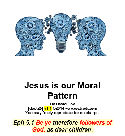The Purposes of the Incarnation
By Rev. G. Campbell Morgan, D. D.
Former Pastor of Westminster Chapel, London, England
In this short work (4 chapters)Purposes of the Incarnation Pastor Morgan takes up the purposes of the Incarnation: (1) to reveal God the Father, (2) to take away sins, (3) to destroy the works of the Devil, and (4) to prepare for a second Advent.
Contents of Purposes of the Incarnation
Foreword
The Purposes of the Incarnation

Brown The Devil's Mission of Amusement 7 page article from 1889. Hollywood in the church and her ministries. Brown was a student of C.H Spurgeon.
Excerpts:
Different days demand their own special testimony. The watchman who would be faithful to his Lord and to the city of his God needs to carefully note the signs of the times and to emphasize his witness accordingly. Concerning the testimony needed now, there can be little if any doubt. An evil is in the professed camp of the Lord, that is so gross, so brazen in its impudence, that the most shortsighted of spiritual men can hardly fail to notice it.... Amusement for the people is the leading article advertised by each... until the hideous fact has been proved up to the hilt, that "amusement" is ousting "the preaching of the Gospel" as the great attraction... The Concert is fast becoming as much a recognized part of church life as the Prayer Meeting; and it is already, in most places, far better attended.
"Providing recreation for the people" will soon be looked upon as a necessary part of Christian work, and as binding upon the Church of God, as though it were a Divine command, unless some strong voices are raised which will make themselves heard.
Read the 7-page article: Brown, The Devil's Mission of Amusement.
1. To Reveal the Father
2. To Take Away Sins
3. To Destroy the Works of the Devil
4. To Prepare for a Second Advent
More from this category if available: Incarnation
- Morgan, G.C. – The Purposes of the Incarnation
- Morgan, G.C. – The Purpose Of The Advent
- Machen Virgin Birth of Christ
- Hocking, W.J. – Christ Jesus Emptying Himself
- Athanasius – On the Incarnation
Foreword of Purposes of the Incarnation
The title of this meditation marks its limitation, and indicates its scope.
Here is no attempt at defense of the statement of the New Testament that “the Word was made flesh.” That is taken for granted as true.
Moreover, here is no attempt to explain the method of the Holy Mystery. That is recognized as Mystery: a fact revealed which is yet beyond human comprehension or explanation.
The scope is that of considering in broad outline the plain teaching of the New Testament as to the purposes of the Incarnation.
Its final limitation is that of its brevity. If, however, it serve to arouse a deeper sense of the wonder of the great central fact of our common Faith, and thus to inspire further meditation, its object will be gained.
The Incarnation
The whole teaching of Holy Scripture places the Incarnation at the center of the methods of God with a sinning race.
Toward that Incarnation everything moved until its accomplishment, finding therein fulfillment and explanation. The messages of the prophets and seers and the songs of the psalmists trembled with more or less certainty toward the final music which announced the coming of Christ. All the results also of these partial and broken messages of the past led toward the Incarnation.
It is equally true that from that Incarnation all subsequent movements have proceeded, depending upon it for direction and dynamic. The Gospel stories are all concerned with the coming of Christ, with His mission and His message. The letters of the New Testament have all to do with the fact of the Incarnation, and its correlated doctrines and duties. The last book of the Bible is a book, the true title of which is The Unveiling of the Christ.
Not only the actual messages which have been bound up in this one Divine Library, but all the results issuing from them, are finally results issuing from this self-same coming of Christ. It is surely important, therefore, that we should understand its purposes in the economy of God.
There is a fourfold statement of purpose declared in the New Testament: the purpose to reveal the Father; the purpose to put away sin; the purpose to destroy the works of the devil; and the purpose to establish by another advent the Kingdom of God in the world.
Christ was in conflict with all that was contrary to the purposes of God in individual, social, national, and racial life. There is a sense in which when we have said this we have stated the whole meaning of His coming. His revelation of the Father was toward this end; His putting away of sin was part of this very process; and His second advent will be for the complete and final overthrow of all the works of the devil.
More Works by Morgan
- Morgan, G.C. – The True Estimate of Life and How to Live it
- Morgan, G.C. – The Teaching of Christ
- Morgan, G.C. – The Purposes of the Incarnation
- Morgan, G.C. – The Purpose Of The Advent
- Morgan, G.C. – The Practice of Prayer
- Morgan, G.C. – The Parables of the Kingdom
- Morgan, G.C. – The Gospel according to Mark

doct25 Jesus is our Moral Pattern explains how "receiving Jesus" also means being like Jesus in our moral character. We "follow God" as His children.
Download: doct25 Jesus is our Moral Pattern
MySwordmodules is a website dedicate to the MySword Bible Program for Androird devices. We host MySword Modules.

Donate to David Cox Ministries I have 34 websites, about half in English and half in Spanish. All of these sites are either religious blogs or sites specifically to support and offer free modules for Bible Software. Some of them have over 1000 free religious books for Bible study. I have to pay for all of this somehow, and most months, the entire amount of all websites are on my shoulders alone.
Please donate something today!
